What Is Parallax Used For

A simplified illustration of the parallax of an object against a afar background due to a perspective shift. When viewed from "Viewpoint A", the object appears to be in front of the blue square. When the viewpoint is changed to "Viewpoint B", the object appears to have moved in front of the red square.
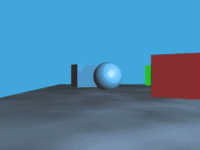
This animation is an instance of parallax. Equally the viewpoint moves side to side, the objects in the distance appear to move more slowly than the objects close to the camera. In this instance, the white cube in forepart appears to move faster than the green cube in the middle of the far background.
Parallax is a displacement or difference in the apparent position of an object viewed along two different lines of sight, and is measured by the angle or semi-angle of inclination between those ii lines.[i] [2] Due to foreshortening, nearby objects testify a larger parallax than farther objects when observed from different positions, then parallax tin be used to determine distances.
To measure big distances, such every bit the distance of a planet or a star from Earth, astronomers apply the principle of parallax. Hither, the term parallax is the semi-angle of inclination between two sight-lines to the star, as observed when World is on reverse sides of the Sun in its orbit.[a] These distances form the lowest rung of what is called "the catholic distance ladder", the starting time in a succession of methods by which astronomers decide the distances to celestial objects, serving as a basis for other distance measurements in astronomy forming the higher rungs of the ladder.
Parallax too affects optical instruments such equally burglarize scopes, binoculars, microscopes, and twin-lens reflex cameras that view objects from slightly different angles. Many animals, forth with humans, have 2 eyes with overlapping visual fields that employ parallax to gain depth perception; this process is known as stereopsis. In computer vision the consequence is used for computer stereo vision, and at that place is a device called a parallax rangefinder that uses information technology to notice range, and in some variations also altitude to a target.
A simple everyday case of parallax can be seen in the dashboards of motor vehicles that use a needle-style mechanical speedometer. When viewed from directly in front, the speed may evidence exactly sixty, but when viewed from the rider seat, the needle may appear to prove a slightly dissimilar speed due to the angle of viewing combined with deportation of the needle from the plane of the numerical dial.
Visual perception [edit]

In this photograph, the Lord's day is visible to a higher place the top of the streetlight. In the reflection on the h2o, the Sun appears in line with the streetlight because the virtual image is formed from a dissimilar viewing position.
Every bit the optics of humans and other animals are in unlike positions on the head, they present different views simultaneously. This is the basis of stereopsis, the process by which the brain exploits the parallax due to the dissimilar views from the eye to gain depth perception and approximate distances to objects.[3] Animals also utilise motion parallax, in which the animals (or but the head) motion to proceeds different viewpoints. For example, pigeons (whose eyes do not accept overlapping fields of view and thus cannot use stereopsis) bob their heads upward and down to meet depth.[iv]
The movement parallax is exploited besides in wiggle stereoscopy, computer graphics which provide depth cues through viewpoint-shifting animation rather than through binocular vision.
Astronomy [edit]

Parallax is an bending subtended by a line on a bespeak. In the upper diagram, the Earth in its orbit sweeps the parallax angle subtended on the Sun. The lower diagram shows an equal angle swept by the Sunday in a geostatic model. A like diagram can be drawn for a star except that the angle of parallax would be minuscule.
Parallax arises due to change in viewpoint occurring due to motion of the observer, of the observed, or of both. What is essential is relative move. By observing parallax, measuring angles, and using geometry, 1 can make up one's mind distance.
Stellar parallax [edit]
Stellar parallax created by the relative motility between the World and a star can exist seen, in the Copernican model, as arising from the orbit of the Earth around the Sun: the star only appears to motion relative to more distant objects in the sky. In a geostatic model, the movement of the star would have to be taken as existent with the star oscillating beyond the sky with respect to the background stars.
Stellar parallax is about frequently measured using annual parallax, defined every bit the divergence in position of a star as seen from the Earth and Sunday, i.due east. the bending subtended at a star by the hateful radius of the Earth's orbit around the Sun. The parsec (3.26 low-cal-years) is defined as the distance for which the annual parallax is i arcsecond. Annual parallax is normally measured by observing the position of a star at dissimilar times of the year as the World moves through its orbit. Measurement of almanac parallax was the starting time reliable way to determine the distances to the closest stars. The first successful measurements of stellar parallax were made past Friedrich Bessel in 1838 for the star 61 Cygni using a heliometer.[v] Stellar parallax remains the standard for calibrating other measurement methods. Authentic calculations of altitude based on stellar parallax crave a measurement of the distance from the World to the Sun, now based on radar reflection off the surfaces of planets.[6]
The angles involved in these calculations are very small and thus hard to measure out. The nearest star to the Sun (and thus the star with the largest parallax), Proxima Centauri, has a parallax of 0.7687 ± 0.0003 arcsec.[7] This angle is approximately that subtended by an object 2 centimeters in diameter located 5.3 kilometers away.

The fact that stellar parallax was so pocket-sized that it was unobservable at the time was used equally the main scientific argument against heliocentrism during the early modern age. It is clear from Euclid'south geometry that the outcome would be undetectable if the stars were far enough away, merely for diverse reasons such gigantic distances involved seemed entirely implausible: it was ane of Tycho'southward primary objections to Copernican heliocentrism that in order for information technology to exist compatible with the lack of observable stellar parallax, there would accept to be an enormous and unlikely void between the orbit of Saturn (so the most distant known planet) and the eighth sphere (the fixed stars).[9]
In 1989, the satellite Hipparcos was launched primarily for obtaining improved parallaxes and proper motions for over 100,000 nearby stars, increasing the reach of the method tenfold. Even so, Hipparcos was only able to measure parallax angles for stars up to about one,600 light-years away, a piffling more than one percent of the bore of the Milky Manner Milky way. The European Space Agency's Gaia mission, launched in Dec 2013, can mensurate parallax angles to an accurateness of 10 microarcseconds, thus mapping nearby stars (and potentially planets) up to a altitude of tens of thousands of light-years from Globe.[10] [11] In Apr 2014, NASA astronomers reported that the Hubble Infinite Telescope, past using spatial scanning, tin precisely measure distances up to 10,000 light-years away, a ten-fold improvement over before measurements.[8]
Distance measurement [edit]

Distance measurement by parallax is a special instance of the principle of triangulation, which states that one tin can solve for all the sides and angles in a network of triangles if, in add-on to all the angles in the network, the length of at least one side has been measured. Thus, the careful measurement of the length of one baseline can fix the scale of an entire triangulation network. In parallax, the triangle is extremely long and narrow, and by measuring both its shortest side (the motion of the observer) and the small acme bending (always less than 1 arcsecond,[v] leaving the other ii close to 90 degrees), the length of the long sides (in practice considered to exist equal) can exist adamant.
Assuming the bending is minor (see derivation below), the distance to an object (measured in parsecs) is the reciprocal of the parallax (measured in arcseconds): For example, the distance to Proxima Centauri is 1/0.7687 = ane.3009 parsecs (four.243 ly).[7]
Diurnal parallax [edit]
Diurnal parallax is a parallax that varies with rotation of the Earth or with difference of location on the World. The Moon and to a smaller extent the terrestrial planets or asteroids seen from different viewing positions on the Earth (at one given moment) can appear differently placed against the background of stock-still stars.[12] [13]
The diurnal parallax has been used past John Flamsteed in 1672 to measure out the distance to Mars at its opposition and through that to estimate the astronomical unit and the size of the Solar Arrangement.[14]
Lunar parallax [edit]
Lunar parallax (often brusque for lunar horizontal parallax or lunar equatorial horizontal parallax), is a special example of (diurnal) parallax: the Moon, being the nearest celestial body, has by far the largest maximum parallax of any angelic torso, at times exceeding ane caste.[xv]
The diagram for stellar parallax can illustrate lunar parallax also, if the diagram is taken to exist scaled correct downwards and slightly modified. Instead of 'near star', read 'Moon', and instead of taking the circle at the bottom of the diagram to represent the size of the Earth's orbit effectually the Sun, have it to exist the size of the Earth's globe, and of a circle around the Earth'south surface. Then, the lunar (horizontal) parallax amounts to the divergence in angular position, relative to the background of distant stars, of the Moon as seen from two different viewing positions on the Earth: 1 of the viewing positions is the place from which the Moon tin can exist seen directly overhead at a given moment (that is, viewed forth the vertical line in the diagram); and the other viewing position is a identify from which the Moon can be seen on the horizon at the same moment (that is, viewed along one of the diagonal lines, from an Earth-surface position corresponding roughly to 1 of the blue dots on the modified diagram).
The lunar (horizontal) parallax can alternatively exist defined as the bending subtended at the distance of the Moon past the radius of the Earth[16] [17]—equal to angle p in the diagram when scaled-down and modified as mentioned higher up.
The lunar horizontal parallax at any time depends on the linear distance of the Moon from the Earth. The Earth–Moon linear distance varies continuously as the Moon follows its perturbed and approximately elliptical orbit around the Earth. The range of the variation in linear altitude is from about 56 to 63.7 World radii, corresponding to horizontal parallax of about a degree of arc, but ranging from about 61.iv' to about 54'.[15] The Astronomical Almanac and similar publications tabulate the lunar horizontal parallax and/or the linear distance of the Moon from the Earth on a periodical e.g. daily footing for the convenience of astronomers (and of angelic navigators), and the written report of the way in which this coordinate varies with fourth dimension forms function of lunar theory.
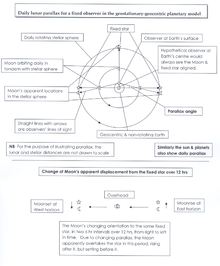
Diagram of daily lunar parallax
Parallax can also be used to decide the distance to the Moon.
Ane manner to determine the lunar parallax from one location is by using a lunar eclipse. A full shadow of the Earth on the Moon has an apparent radius of curvature equal to the difference betwixt the apparent radii of the Earth and the Sun as seen from the Moon. This radius tin be seen to be equal to 0.75 caste, from which (with the solar credible radius 0.25 degree) we become an World apparent radius of 1 caste. This yields for the Earth–Moon distance threescore.27 World radii or 384,399 kilometres (238,854 mi) This process was first used by Aristarchus of Samos[xviii] and Hipparchus, and afterward found its mode into the piece of work of Ptolemy.[nineteen] The diagram at the right shows how daily lunar parallax arises on the geocentric and geostatic planetary model in which the Earth is at the centre of the planetary organization and does non rotate. Information technology also illustrates the important point that parallax need non be acquired by any motion of the observer, contrary to some definitions of parallax that say it is, but may arise purely from motion of the observed.
Some other method is to accept two pictures of the Moon at exactly the same fourth dimension from 2 locations on Earth and compare the positions of the Moon relative to the stars. Using the orientation of the Earth, those two position measurements, and the distance betwixt the two locations on the Earth, the distance to the Moon tin be triangulated:

Example of lunar parallax: Occultation of Pleiades by the Moon
This is the method referred to past Jules Verne in From the Earth to the Moon:
Until then, many people had no idea how i could calculate the distance separating the Moon from the World. The circumstance was exploited to teach them that this distance was obtained by measuring the parallax of the Moon. If the discussion parallax appeared to astonish them, they were told that information technology was the angle subtended by ii direct lines running from both ends of the World'south radius to the Moon. If they had doubts on the perfection of this method, they were immediately shown that not only did this mean altitude amount to a whole two hundred thirty-four grand three hundred and forty-seven miles (94,330 leagues), but also that the astronomers were non in mistake by more than than seventy miles (≈ thirty leagues).
Solar parallax [edit]
Later on Copernicus proposed his heliocentric system, with the Globe in revolution around the Sun, information technology was possible to build a model of the whole Solar Arrangement without scale. To ascertain the scale, it is necessary only to measure one distance within the Solar System, e.grand., the mean distance from the Globe to the Sun (now called an astronomical unit, or AU). When institute past triangulation, this is referred to every bit the solar parallax, the difference in position of the Sun equally seen from the Earth's middle and a point one Globe radius abroad, i.e., the angle subtended at the Sun by the Earth's mean radius. Knowing the solar parallax and the hateful Earth radius allows one to calculate the AU, the first, modest step on the long route of establishing the size and expansion age[twenty] of the visible Universe.
A primitive way to determine the distance to the Sun in terms of the distance to the Moon was already proposed by Aristarchus of Samos in his volume On the Sizes and Distances of the Sun and Moon. He noted that the Sun, Moon, and World class a right triangle (with the right angle at the Moon) at the moment of outset or last quarter moon. He and so estimated that the Moon–Earth–Sun angle was 87°. Using correct geometry but inaccurate observational data, Aristarchus concluded that the Sun was slightly less than twenty times farther away than the Moon. The true value of this bending is close to 89° fifty', and the Dominicus is actually about 390 times further away.[18] He pointed out that the Moon and Sun have near equal credible angular sizes and therefore their diameters must be in proportion to their distances from Earth. He thus concluded that the Dominicus was around twenty times larger than the Moon; this conclusion, although incorrect, follows logically from his incorrect data. Information technology does suggest that the Lord's day is conspicuously larger than the Earth, which could exist taken to support the heliocentric model.[21]
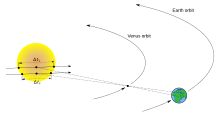
Measuring Venus transit times to determine solar parallax
Although Aristarchus' results were incorrect due to observational errors, they were based on correct geometric principles of parallax, and became the ground for estimates of the size of the Solar System for most 2000 years, until the transit of Venus was correctly observed in 1761 and 1769.[18] This method was proposed by Edmond Halley in 1716, although he did non live to run across the results. The use of Venus transits was less successful than had been hoped due to the blackness drop effect, but the resulting estimate, 153 meg kilometers, is merely 2% above the currently accepted value, 149.half dozen one thousand thousand kilometers.
Much later, the Solar System was "scaled" using the parallax of asteroids, some of which, such every bit Eros, pass much closer to Earth than Venus. In a favourable opposition, Eros can approach the Earth to within 22 million kilometres.[22] During the opposition of 1900–1901, a worldwide program was launched to make parallax measurements of Eros to determine the solar parallax (or distance to the Sun), with the results published in 1910 by Arthur Hinks of Cambridge[23] and Charles D. Perrine of the Lick Observatory, University of California.[24] Perrine published progress reports in 1906[25] and 1908.[26] He took 965 photographs with the Crossley Reflector and selected 525 for measurement.[27] A similar program was then carried out, during a closer approach, in 1930–1931 by Harold Spencer Jones.[28] The value of the Astronomical Unit (roughly the Globe-Sun altitude) obtained by this program was considered definitive until 1968, when radar and dynamical parallax methods started producing more precise measurements.
As well radar reflections, both off Venus (1958) and off asteroids, like Icarus, take been used for solar parallax conclusion. Today, use of spacecraft telemetry links has solved this one-time trouble. The currently accustomed value of solar parallax is viii".794 143.[29]
Moving-cluster parallax [edit]
The open stellar cluster Hyades in Taurus extends over such a big part of the sky, twenty degrees, that the proper motions as derived from astrometry appear to converge with some precision to a perspective point north of Orion. Combining the observed apparent (angular) proper motion in seconds of arc with the too observed true (accented) receding move every bit witnessed by the Doppler redshift of the stellar spectral lines, allows interpretation of the distance to the cluster (151 lite-years) and its fellow member stars in much the same style as using almanac parallax.[30]
Dynamical parallax [edit]
Dynamical parallax has sometimes also been used to decide the distance to a supernova, when the optical wave front of the burst is seen to propagate through the surrounding dust clouds at an apparent athwart velocity, while its true propagation velocity is known to be the speed of light.[31]
Derivation [edit]
For a right triangle,
where is the parallax, 1 au (149,600,000 km) is approximately the boilerplate distance from the Sun to Earth, and is the distance to the star. Using small-angle approximations (valid when the angle is small-scale compared to 1 radian),
so the parallax, measured in arcseconds, is
If the parallax is one", then the distance is
This defines the parsec, a convenient unit for measuring distance using parallax. Therefore, the altitude, measured in parsecs, is but , when the parallax is given in arcseconds.[32]
Error [edit]
Precise parallax measurements of distance have an associated fault. This fault in the measured parallax angle does not interpret straight into an error for the distance, except for relatively small errors. The reason for this is that an mistake toward a smaller angle results in a greater error in distance than an error toward a larger angle.
However, an approximation of the distance mistake can be computed by
where d is the distance and p is the parallax. The approximation is far more than accurate for parallax errors that are small relative to the parallax than for relatively big errors. For meaningful results in stellar astronomy, Dutch astronomer Floor van Leeuwen recommends that the parallax error exist no more than 10% of the total parallax when computing this fault estimate.[33]
Spatio-temporal parallax [edit]
From enhanced relativistic positioning systems, spatio-temporal parallax generalizing the usual notion of parallax in space simply has been developed. And so, eventfields in spacetime can be deduced direct without intermediate models of lite bending past massive bodies such as the one used in the PPN ceremonial for instance.[34]
Metrology [edit]
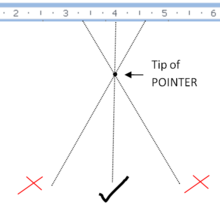
The correct line of sight needs to be used to avert parallax error.
Measurements made by viewing the position of some marker relative to something to be measured are subject to parallax error if the marker is some altitude away from the object of measurement and not viewed from the correct position. For example, if measuring the altitude between 2 ticks on a line with a ruler marked on its top surface, the thickness of the ruler will separate its markings from the ticks. If viewed from a position not exactly perpendicular to the ruler, the credible position will shift and the reading will exist less accurate than the ruler is capable of.
A similar error occurs when reading the position of a pointer against a calibration in an instrument such as an analog multimeter. To help the user avoid this problem, the calibration is sometimes printed above a narrow strip of mirror, and the user's eye is positioned so that the arrow obscures its own reflection, guaranteeing that the user's line of sight is perpendicular to the mirror and therefore to the scale. The same effect alters the speed read on a car'south speedometer by a driver in front of it and a passenger off to the side, values read from a graticule not in actual contact with the display on an oscilloscope, etc.
Photogrammetry [edit]
Aerial film pairs, when viewed through a stereo viewer, offer a pronounced stereo effect of mural and buildings. High buildings appear to "keel over" in the management away from the center of the photograph. Measurements of this parallax are used to deduce the height of the buildings, provided that flying height and baseline distances are known. This is a central component to the procedure of photogrammetry.
Photography [edit]

Contax III rangefinder camera with macro photography setting. Considering the viewfinder is on top of the lens and of the close proximity of the subject, goggles are fitted in front of the rangefinder and a defended viewfinder installed to recoup for parallax.

Failed panoramic paradigm due to the parallax, since centrality of rotation of tripod is not same of focal point.
Parallax error can be seen when taking photos with many types of cameras, such as twin-lens reflex cameras and those including viewfinders (such as rangefinder cameras). In such cameras, the eye sees the subject area through different eyes (the viewfinder, or a 2nd lens) than the one through which the photo is taken. Every bit the viewfinder is often found higher up the lens of the camera, photos with parallax fault are frequently slightly lower than intended, the classic instance beingness the epitome of person with their head cropped off. This problem is addressed in single-lens reflex cameras, in which the viewfinder sees through the aforementioned lens through which the photo is taken (with the aid of a movable mirror), thus fugitive parallax error.
Parallax is also an issue in image stitching, such equally for panoramas.
Weapon sights [edit]
Parallax affects sighting devices of ranged weapons in many ways. On sights fitted on minor artillery and bows, etc., the perpendicular distance between the sight and the weapon's launch axis (e.k. the bore axis of a gun)—mostly referred to every bit "sight height"—can induce significant aiming errors when shooting at close range, especially when shooting at small targets.[35] This parallax error is compensated for (when needed) via calculations that also have in other variables such equally bullet drib, windage, and the altitude at which the target is expected to exist.[36] Sight elevation tin can be used to reward when "sighting in" rifles for field use. A typical hunting rifle (.222 with telescopic sights) sighted in at 75m volition still exist useful from 50 to 200 m (55 to 219 yd) without needing further adjustment.[ citation needed ]
Optical sights [edit]
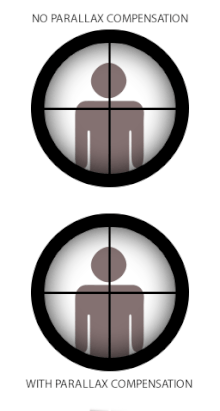
Simple blitheness demonstrating the effects of parallax compensation in scope sights, equally the eye moves relative to the sight.
In some reticled optical instruments such every bit telescopes, microscopes or in scope sights ("scopes") used on small artillery and theodolites, parallax can create problems when the reticle is not coincident with the focal plane of the target prototype. This is because when the reticle and the target are not at the same focus, the optically corresponded distances being projected through the eyepiece are likewise dissimilar, and the user's heart volition register the divergence in parallaxes between the reticle and the target (whenever eye position changes) every bit a relative displacement on top of each other. The term parallax shift refers to that resultant apparent "floating" movements of the reticle over the target image when the user moves his/her head/center laterally (up/down or left/right) backside the sight,[37] i.e. an error where the reticle does non stay aligned with the user's optical centrality.
Some firearm scopes are equipped with a parallax bounty mechanism, which basically consists of a movable optical element that enables the optical organisation to shift the focus of the target prototype at varying distances into exactly the same optical airplane of the reticle (or vice versa). Many low-tier scope sights may take no parallax compensation considering in practice they can still perform very acceptably without eliminating parallax shift, in which example the telescopic is often set up fixed at a designated parallax-free distance that all-time suits their intended usage. Typical standard mill parallax-free distances for hunting scopes are 100 yd (or 90 1000) to brand them suited for hunting shots that rarely exceed 300 yd/thousand. Some competition and military-style scopes without parallax compensation may be adapted to be parallax costless at ranges up to 300 yd/1000 to make them better suited for aiming at longer ranges.[ citation needed ] Scopes for guns with shorter applied ranges, such as airguns, rimfire rifles, shotguns and muzzleloaders, will have parallax settings for shorter distances, commonly 50 one thousand (55 yd) for rimfire scopes and 100 m (110 yd) for shotguns and muzzleloaders.[ citation needed ] Airgun scopes are very oft constitute with adjustable parallax, unremarkably in the form of an adjustable objective (or "AO" for curt) blueprint, and may adjust downwardly to as about as 3 metres (3.3 yd).[ commendation needed ]
Non-magnifying reflector or "reflex" sights have the ability to be theoretically "parallax free." But since these sights use parallel collimated light this is only true when the target is at infinity. At finite distances eye movement perpendicular to the device will cause parallax movement in the reticle paradigm in verbal relationship to middle position in the cylindrical column of calorie-free created by the collimating optics.[38] [39] Firearm sights, such as some red dot sights, try to correct for this via non focusing the reticle at infinity, but instead at some finite distance, a designed target range where the reticle will show very little movement due to parallax.[38] Some manufactures market reflector sight models they phone call "parallax costless,"[40] just this refers to an optical system that compensates for off centrality spherical aberration, an optical error induced by the spherical mirror used in the sight that can cause the reticle position to diverge off the sight'southward optical axis with modify in eye position.[41] [42]
Artillery gunfire [edit]
Considering of the positioning of field or naval artillery guns, each one has a slightly dissimilar perspective of the target relative to the location of the fire-command system itself. Therefore, when aiming its guns at the target, the fire command arrangement must recoup for parallax in gild to assure that fire from each gun converges on the target.
Rangefinders [edit]

Parallax theory for finding naval distances
A coincidence rangefinder or parallax rangefinder can be used to find altitude to a target.
Art [edit]


Viewed from a certain angle the curves of the 3 dissever columns of The Darwin Gate appear to form a dome
Several of Mark Renn's sculptural works play with parallax, appearing abstract until viewed from a specific angle. One such sculpture is The Darwin Gate (pictured) in Shrewsbury, England, which from a certain angle appears to form a dome, according to Celebrated England, in "the class of a Saxon helmet with a Norman window... inspired by features of St Mary's Church which was attended by Charles Darwin as a male child".[43]
As a metaphor [edit]
In a philosophic/geometric sense: an apparent change in the direction of an object, caused past a alter in observational position that provides a new line of sight. The credible displacement, or difference of position, of an object, as seen from two different stations, or points of view. In contemporary writing parallax can also exist the same story, or a similar story from approximately the same time line, from one book told from a different perspective in another volume. The word and concept feature prominently in James Joyce'due south 1922 novel, Ulysses. Orson Scott Card also used the term when referring to Ender's Shadow as compared to Ender'due south Game.
The metaphor is invoked by Slovene philosopher Slavoj Žižek in his 2006 volume The Parallax View, borrowing the concept of "parallax view" from the Japanese philosopher and literary critic Kojin Karatani. Žižek notes,
The philosophical twist to be added (to parallax), of course, is that the observed altitude is non simply subjective, since the same object that exists 'out there' is seen from two different stances, or points of view. It is rather that, every bit Hegel would accept put it, subject and object are inherently mediated then that an 'epistemological' shift in the subject's point of view ever reflects an ontological shift in the object itself. Or—to put information technology in Lacanese—the subject's gaze is e'er-already inscribed into the perceived object itself, in the guise of its 'blind spot,' that which is 'in the object more than object itself', the point from which the object itself returns the gaze. Certain the picture is in my eye, simply I am too in the picture.[44]
—Slavoj Žižek, The Parallax View
See too [edit]
- Binocular disparity
- Lutz–Kelker bias
- Parallax mapping, in computer graphics
- Parallax scrolling, in computer graphics
- Refraction, a visually like principle caused by h2o, etc.
- Spectroscopic parallax
- Triangulation, wherein a point is calculated given its angles from other known points
- Trigonometry
- True range multilateration, wherein a point is calculated given its distances from other known points
- Xallarap
Notes [edit]
- ^ In the past diurnal parallax was as well used to measure distances to celestial objects within the Solar System. This method has now been superseded by more accurate techniques.
References [edit]
- ^ "Parallax". Shorter Oxford English language Dictionary. 1968.
Mutual inclination of two lines coming together in an angle
- ^ "Parallax". Oxford English Lexicon (Second ed.). 1989.
Astron. Credible displacement, or departure in the apparent position, of an object, caused by bodily change (or difference) of position of the bespeak of observation; spec. the angular amount of such deportation or departure of position, existence the angle contained between the two straight lines drawn to the object from the ii unlike points of view, and constituting a measure of the distance of the object.
- ^ Steinman, Scott B.; Garzia, Ralph Philip (2000). Foundations of Binocular Vision: A Clinical perspective. McGraw-Hill Professional person. pp. 2–5. ISBN978-0-8385-2670-v.
- ^ Steinman & Garzia 2000, p. 180.
- ^ a b Zeilik & Gregory 1998, p. 44.
- ^ Zeilik & Gregory 1998, § 22-iii.
- ^ a b Benedict, G. Fritz, et al. (1999). "Interferometric Astrometry of Proxima Centauri and Barnard'southward Star Using Hubble Space Telescope Fine Guidance Sensor 3: Detection Limits for Substellar Companions". The Astronomical Periodical. 118 (2): 1086–1100. arXiv:astro-ph/9905318. Bibcode:1999AJ....118.1086B. doi:ten.1086/300975. S2CID 18099356.
- ^ a b Harrington, J.D.; Villard, Ray (10 April 2014). "NASA'south Hubble Extends Stellar Tape Mensurate 10 Times Further Into Space". NASA. Archived from the original on 12 Apr 2014. Retrieved 11 Apr 2014.
- ^ Dobrzycki, J. (1973). Dobrzycki, Jerzy (ed.). The Reception of Copernicus' Heliocentric Theory. p. 51. doi:ten.1007/978-94-015-7614-7. ISBN978-90-481-8340-i.
- ^ "Soyuz ST-B successfully launches Gaia space observatory". nasaspaceflight.com. 19 December 2013. Archived from the original on 19 Dec 2013. Retrieved nineteen December 2013.
- ^ Henney, Paul J. "ESA'due south Gaia Mission to report stars". Astronomy Today. Archived from the original on 2008-03-17. Retrieved 2008-03-08 .
- ^ Seidelmann, P. Kenneth (2005). Explanatory Supplement to the Astronomical Almanac. University Science Books. pp. 123–125. ISBN978-1-891389-45-0.
- ^ Barbieri, Cesare (2007). Fundamentals of astronomy. CRC Press. pp. 132–135. ISBN978-0-7503-0886-1.
- ^ Van Helden, A. (2010). Measuring the universe: cosmic dimensions from Aristarchus to Halley. Academy of Chicago Printing. Ch. 12.
- ^ a b "D". The Astronomical Almanac. [Section of Defense], Navy Department, Naval Observatory, Nautical Almanac Office. 1981.
- ^ The Astronomical Almanac. [Department of Defense], Navy Department, Naval Observatory, Nautical Almanac Function. 1981. p. M10.
- ^ U.s.a. Naval Observatory. Nautical Almanac Office; Great Uk. Nautical Almanac Function (2006). Explanatory Supplement to the Astronomical Almanac . University Science Books. p. 125. ISBN978-1-891389-45-0.
- ^ a b c Gutzwiller, Martin C. (1998). "Moon–Earth–Sun: The oldest iii-body problem". Reviews of Modern Physics. 70 (2): 589–639. Bibcode:1998RvMP...70..589G. doi:x.1103/RevModPhys.lxx.589.
- ^ Webb, Stephen (1999), "3.2 Aristarchus, Hipparchus, and Ptolemy", Measuring the Universe: The Cosmological Altitude Ladder, Springer, pp. 27–35, ISBN9781852331061 . Encounter in detail p. 33: "Near everything nosotros know about Hipparchus comes down to the states by way of Ptolemy."
- ^ Freedman, W.L. (2000). "The Hubble constant and the expansion age of the Universe". Physics Reports. 333 (1): 13–31. arXiv:astro-ph/9909076. Bibcode:2000PhR...333...13F. doi:10.1016/S0370-1573(00)00013-two. S2CID 413222.
- ^ Al-Khalili, Jim (2010), Pathfinders: The Gilded Age of Arabic Science, Penguin U.k., p. 270, ISBN9780141965017, archived from the original on 2015-03-17,
Some accept suggested that his calculation of the relative size of the earth and lord's day led Aristarchus to conclude that it fabricated more sense for the earth to be moving around the much larger sun than the other fashion round.
- ^ Whipple 2007, p. 47.
- ^ Hinks, Arthur R. (1909). "Solar Parallax Papers No. 7: The General Solution from the Photographic Right Ascensions of Eros, at the Opposition of 1900". Monthly Notices of the Royal Astronomical Society. 69 (7): 544–67. Bibcode:1909MNRAS..69..544H. doi:10.1093/mnras/69.vii.544.
- ^ Perrine, Charles D. (1910). Determination of the solar parallax from photographs of Eros fabricated with the Crossley reflector of the Lick Observatory University of California (Starting time ed.). Washington, D. C.: Carnegie Institution of Washington. pp. one–104.
- ^ Perrine, C. D. (1906). "The Measurement and Reduction of the Photographs of Eros Made With the Crossley Reflector in 1900". Publications of the Astronomical Guild of the Pacific. eighteen (10): 226.
- ^ Perrine, Charles D. (1908). "Progress on the Crossley Eros Solar Parallax Work". Publications of the Astronomical Gild of the Pacific. 20 (120): 184. Bibcode:1908PASP...twenty..184P. doi:10.1086/121816. S2CID 121782316.
- ^ Campbell, Westward. West. (1906). "Reports of the Observatories: Lick Observatory". Publications of the Astronomical Lodge of the Pacific. 19 (113): 92.
- ^ Jones, H. Spencer (1941). "The Solar Parallax and the Mass of the Moon from Observations of Eros at the Opposition of 1931". Mem. Roy. Astron. Soc. 66: 11–66.
- ^ "Astronomical Constants" (PDF). Us Naval Observatory. Archived from the original (PDF) on 2011-07-20.
- ^ Vijay K. Narayanan; Andrew Gould (1999). "A Precision Exam of Hipparcos Systematics toward the Hyades". The Astrophysical Journal. 515 (ane): 256. arXiv:astro-ph/9808284. Bibcode:1999ApJ...515..256N. doi:10.1086/307021. S2CID 15351552.
- ^ Panagia, N.; Gilmozzi, R.; MacChetto, F.; Adorf, H.-1000.; et al. (1991). "Properties of the SN 1987A circumstellar ring and the altitude to the Big Magellanic Cloud". The Astrophysical Journal. 380: L23. Bibcode:1991ApJ...380L..23P. doi:ten.1086/186164.
- ^ Similar derivations are in almost astronomy textbooks. See, e.chiliad., Zeilik & Gregory 1998, § eleven-1.
- ^ van Leeuwen, Floor (2007). Hipparcos, the new reduction of the raw data. Astrophysics and space science library. Vol. 350. Springer. p. 86. ISBN978-1-4020-6341-i. Archived from the original on 2015-03-18.
- ^ Rubin, J.L. (2015). "Relativistic Pentametric Coordinates from Relativistic Localizing Systems and the Projective Geometry of the Spacetime Manifold". Electronic Journal of Theoretical Physics. 12 (32): 83–112. Archived from the original on 2015-02-08.
- ^ "Ballistic Explorer Assistance". www.dexadine.com. Archived from the original on 2011-09-28.
- ^ "Crossbows / Arrows & Bolts / Trajectory / Trajectories". www.crossbowmen.com. Archived from the original on 2011-07-08.
- ^ "Setting Up An Air Rifle And Scope Sight For Field Target – An Instruction Manual For Beginners, folio 16". Retrieved 2019-10-28 .
- ^ a b "Encyclopedia of Bullseye Pistol". www.bullseyepistol.com. Archived from the original on 2011-07-08.
- ^ John P. Butler (1944). "The Reflector Sight". American Rifleman. National Rifle Association. p. 31.
- ^ AFMOTGN (24 July 2008). "Aimpoint's parallax-costless, double lens organization... AFMO.com". Archived from the original on 2 July 2016 – via YouTube.
- ^ AR15.COM. "How Aimpoints, EOTechs, And Other Parallax-Gratis Optics Piece of work – AR15.COM". world wide web.ar15.com.
- ^ "Gunsight – Patent 5901452 – general description of a mangin mirror system". Archived from the original on 2012-10-07.
- ^ Historic England. "Darwin Gate (1490992)". Research records (formerly PastScape) . Retrieved 4 January 2020.
- ^ Žižek, Slavoj (2006). The Parallax View. The MIT Printing. pp. 17. ISBN978-0-262-24051-ii.
Bibliography [edit]
- Hirshfeld, Alan w. (2001). Parallax: The Race to Measure the Creation. New York: W.H. Freeman. ISBN978-0-7167-3711-7.
- Whipple, Fred L. (2007). Earth Moon and Planets. Read Books. ISBN978-1-4067-6413-0. .
- Zeilik, Michael A.; Gregory, Stephan A. (1998). Introductory Astronomy & Astrophysics (4th ed.). Saunders Higher Publishing. ISBN978-0-03-006228-5. .
External links [edit]
- Instructions for having groundwork images on a web page use parallax furnishings
- Actual parallax projection measuring the distance to the moon within two.3%
- BBC's Sky at Night programme: Patrick Moore demonstrates Parallax using Cricket. (Requires RealPlayer)
- Berkeley Center for Cosmological Physics Parallax
- Parallax on an educational website, including a quick gauge of altitude based on parallax using eyes and a pollex just
- . Collier's New Encyclopedia. 1921.
What Is Parallax Used For,
Source: https://en.wikipedia.org/wiki/Parallax
Posted by: alexanderdellittef1972.blogspot.com












0 Response to "What Is Parallax Used For"
Post a Comment